Are you looking for backyard trees that come with aesthetics and multi-functionalities? Look no further than hickory trees. These trees are known for many applications, but the most famous contribution is their smoky effect on BBQs.
All types of hickory trees have identifiable features that make them stand out from other deciduous trees. But it can be challenging to pick a specific hickory tree type due to their close similarities around the leaves, bark, and nuts.
This hickory tree guide has a description of hickory tree nuts, leaves, twigs, and bark. The pictures of hickory trees will also help you identify different types of hickory trees in the Carya genus. Let us now find that out together:
What Is a Hickory Tree?
A hickory tree is a large deciduous tree with dense foliages and a spreading canopy. The deciduous tree belongs to the Juglandaceae family and the Carya genus. These trees are native to the temperate rainforest in North America and some parts of Asia.
Hickory trees have egg-shaped nuts, leaves with serrated margins, and gray-flaky bark. Proper maintenance will allow the hickory tree to reach 60-80 ft tall and spread up to 40ft. These deciduous trees are highly prized due to their hardwood, sweet syrup sap, and delicious nuts.
Hickory trees have a long taproot and compound leaves with 3-17 leaflets on each leaf. These leaves usually turn bright yellow in autumn. They also produce flowers that develop into large delicious nuts after pollination.
We recommend planting hickories away from building structures, power lines, and other edible crops. The massive spreading will interfere with the power lines or buildings. Hickories contain a juglone substance that is toxic to plants growing under or around them. (Source: Purdue University).
What Does a Hickory Tree Look Like?
There are over 18 hickory tree varieties, with 12 of these coming from North America, two from Canada, and four from Asia. Each hickory tree type produces unique nuts that are delicious and edible. (Source: Britannica).
Hickory trees are ideal for shade, edible nuts, and hardwood. Hickories are also known as Kings of BBQs due to their sweet and smoky effect on grilled lamb, pork, poultry, and beef. These deciduous trees can grow up to 100 feet tall.
Hickory trees have gray bark with a rigged, furrowed, and rough texture. Some hickory tree species have bark plates curling that gives them a shaggy appearance. The barks peel off easily to expose deep inner bark ridges.
The egg-shaped nuts start as green balls before turning into a light to dark brown color. These nuts have a sweet taste making them ideal for pastries and savory cuisines. Each shell contains a white to the tan-colored hickory kernel.
Hickories have compound leaves that are long and narrow with several leaflets, which have an ovate shape with a pointed tip and serrated margin. The number of leaflets on each leaf varies depending on the hickory tree type.
How to Identify a Hickory Tree
The easiest way to identify hickory trees is by their nuts, bark, twigs, and leaves. Let us now discuss the hickory tree parts to enhance the tree identification process:
Hickory Tree Bark
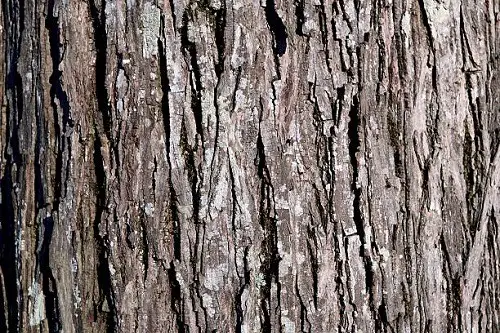
Hickory trees have gray bark that turns darker at maturity. Some hickories have bark plates that curl outward to give them shaggy appearances.
The bark is also furrowed, ridged, and rough in texture. It can pull away easily at maturity to reveal shallow or deep inner bark ridges.
Hickory Tree Leaves
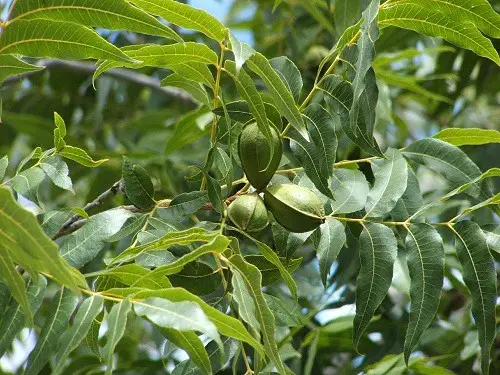
Hickory tree leaves are long and narrow with several leaflets. Each hickory leaflet has an ovate shape, pointed tip, and serrated margins.
Each pinnate compound leaf has an odd number of leaflets that range from 3 to 17. The compound leaf also has a terminal leaf blade from the pairs of leaflets.
Hickory Tree Nuts
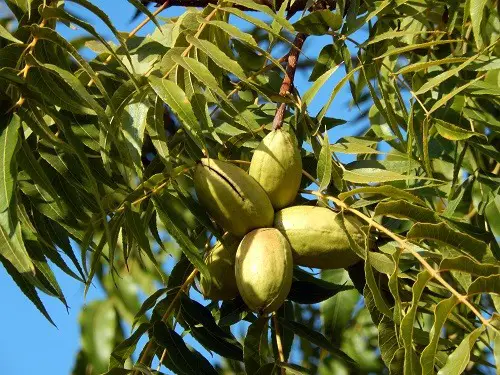
Hickory tree nuts start as green balls before turning into a hard light brown color. The egg-shaped nuts have hard shells that cover the sweet kernel.
Some hickory tree nuts are edible, and others are not. We recommend eating nuts from pecan trees, shellback hickories, and shagbark hickories.
Hickory Tree Wood
Hickory tree wood is strong, hard, and durable. The wood color ranges from medium brown to yellowish to a reddish hue. (Source: University of Tennessee).
Different Types of Hickory Trees with Pictures
Southern Shagbark Hickory (Carya carolinae septentrionalis)
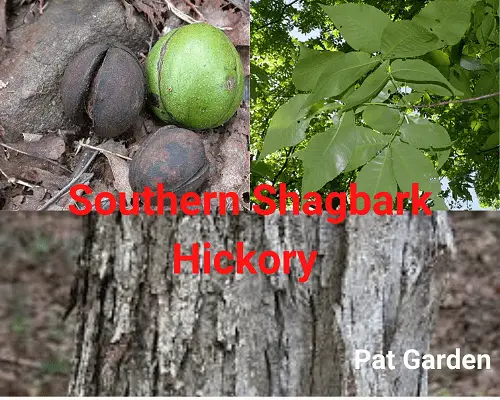
The southern shagbark hickory tree is also known as the Carolina shagbark hickory tree. The hickory tree produces smaller nuts, and its bark usually peels away from the trunk.
The Carolina shagbark can reach 65-100 feet (20-30m) tall. The shaggy-looking tree has a tall and slender trunk that generates branches high.
| Hickory Tree Bark | Gray and peels away in plates |
| Hickory Tree Leaves | Compound leaves. Each pinnate leaf has five obovate-shaped leaflets with serrated margins. |
| Hickory Nut Sizes | Smallest nuts. |
| Maximum Height | 65-100 ft. |
Shellbark Hickory Tree (Carya laciniosa)
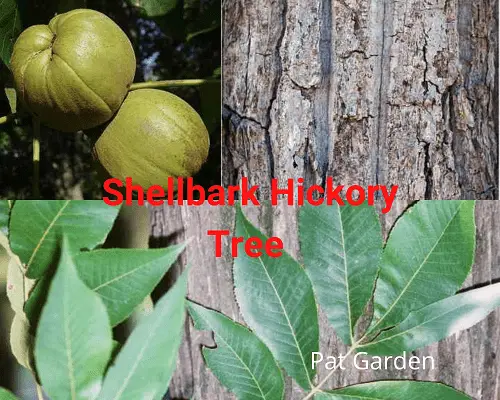
It is a large, slow-growing deciduous tree with a slender trunk that can reach 120 ft tall. The slender trunk has smooth bark with large plates and narrow grooves.
Shellbark hickories have dense twigs, sweet nuts, and compound leaves with up to 7-9 leaflets. It thrives in moist bottomlands and wet forests. Shellbark hickories are also ideal for high-quality woods for tool handles and furniture.
| Hickory Tree Bark | Gray and smooth while young. Mature trunks have gray bark with shallow thin fissures. |
| Hickory Tree Leaves | Pinnate compound leaf with up to 7-9 leaflets. Each leaflet has lanceolate shaped with serrated margins. |
| Hickory Tree Nuts | Large sweet nuts |
| Maximum Height | 120 feet |
Nutmeg Hickory (Carya myristiciformis)
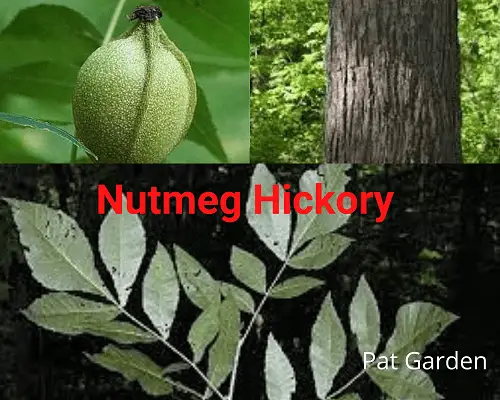
It is among the rarest native hickories with brownish-gray bark that peels in plates. The hickory tree has shiny green leaves with silvery undersides.
The hickory species has reddish-brown round nutshells with patterns looking like nutmegs with sweet kernels. They grow up to 100 feet and are scattered in the southern states.
| Hickory Tree Bark | Brownish-gray |
| Hickory Tree Leaves | Shiny green with silvery undersides |
| Hickory Tree Nuts | Reddish-brown round nutshells |
| Maximum Height | 100feet |
Pignut or Black Hickory (Carya glabra)
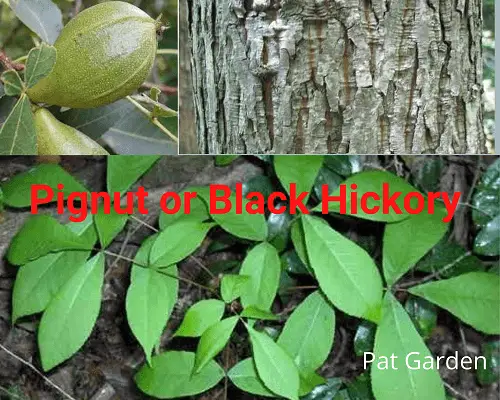
It is also called the smooth bark hickory tree. The pignut hickory has a straight trunk and a massive rounded crown. These hickories can grow up to 50-80ft tall with gray scaly bark that never peels.
Pignut hickory trees thrive in rich dry-moist soil on the slope and hillsides. The attractive growth creates a beautiful ornamental shade in the woodland and open landscapes.
| Hickory Tree Bark | Gray and scaly |
| Hickory Tree Leaves | Smooth lanceolate leaves |
| Hickory Tree Nuts | Pear shape nuts |
| Maximum Height | 50-80ft |
Mockernut Hickory (Carya tomentosa)
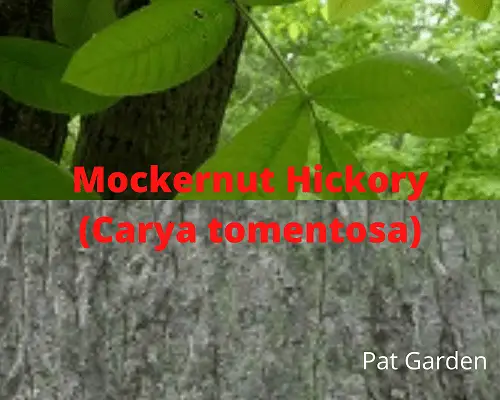
These hickories have thin gray barks with deep narrow furrows. They also have round crowns and produce hard-to-crack nuts.
Mockernut hickories have pinnate compound leaves that are yellowish-green. These hickory trees are also called white hickory trees.
| Hickory Tree Bark | Gray with deep narrow furrows |
| Hickory Tree Leaves | Yellowish-green |
| Hickory Tree Nuts | Hard-to-crack nuts |
| Maximum Height | 60-80ft |
Bitternut Hickory (Carya cordiformis)
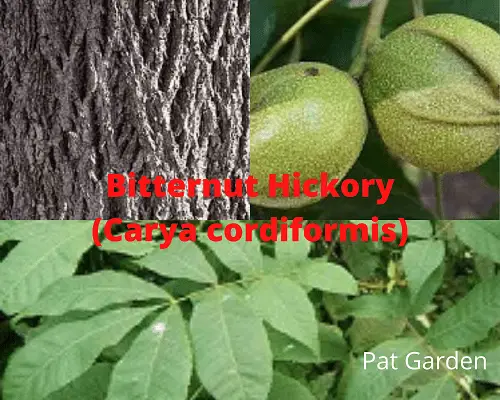
It is the tallest hickory species with large pinnate leaves. The hickory tree also has slender green twigs with grayish bark and diamond patterns furrows.
These hickories grow up to 115 feet with an irregular oval crown. The bitternut hickory nuts are inedible since they have a bitter taste.
| Hickory Tree Bark | Grayish with diamond patterns fissures. |
| Hickory Tree Leaves | Large green pinnate leaves |
| Hickory Tree Nuts | Inedible due to the bitter taste |
| Maximum Height | 115 feet. |
Shagbark Hickory (Carya ovata)
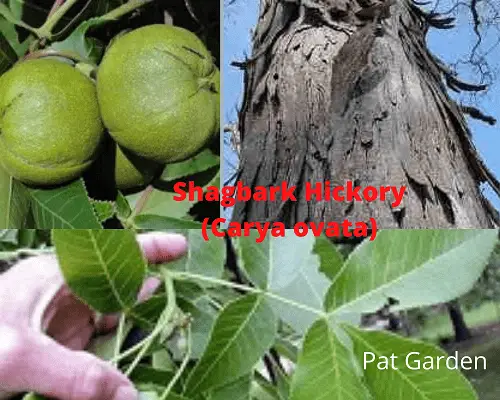
These hickories have gray peeling barks giving the large slender trunk a disheveled appearance and can reach 120ft (36m) tall. But the average height for shagbark hickory is about 60-80ft.
Shagbark hickory trees are deciduous with pinnate compound leaves. Each leaf has about 5-7 rounded leaves. Northern and Southern shagbarks are the two main types of shagbark hickories.
| Hickory Tree Bark | Gray and peeling |
| Hickory Tree Leaves | Slightly rounded and pointed leaflets with serrated margins. |
| Hickory Tree Nuts | Oval hard brown nut with sweet tasting. |
| Maximum Height | 60-80ft |
Scrub Hickory (Carya floridana)
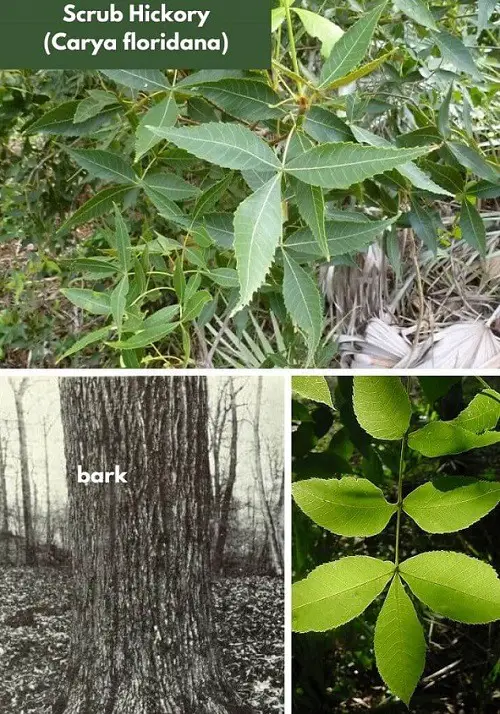
These are tree-shrub hickories with a maximum height of 16ft (5m). But some species grow up to 80ft (25m).
The pinnate compound leaves have several leaflets with serrated edges and produce small edible drupes. They are native to the Southeast United States.
| Hickory Tree Bark | Grayish with shallow furrows |
| Hickory Tree Leaves | Each pinnate leaf has seven leaflets with a pointed leaflet. |
| Hickory Tree Nuts | Small edible drupes |
| Maximum Height | 16ft |
Black Hickory (Carya texana)
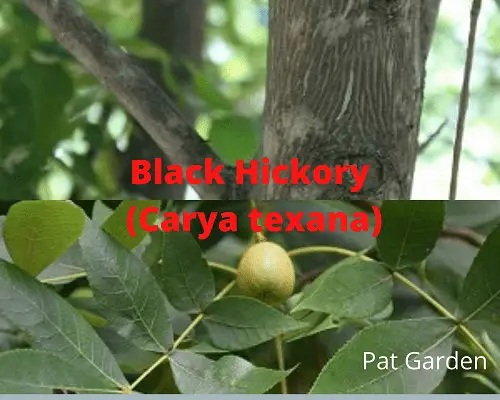
These hickories have dark-colored bark with diamond-shaped ridges and smooth trunks. The pinnate leaves have pairs of lanceolate leaflets and a pointed leaflet.
The foliages are shiny green with dull undersides and slightly serrated margins. These hickories are small and slow-growing trees.
| Hickory Tree Bark | Dark with diamond-shaped ridges |
| Hickory Tree Leaves | Shiny green leaves with serrated edges |
| Hickory Tree Nuts | Edible nuts |
| Maximum Growth | 50 feet |
Sand Hickory (Carya pallida)
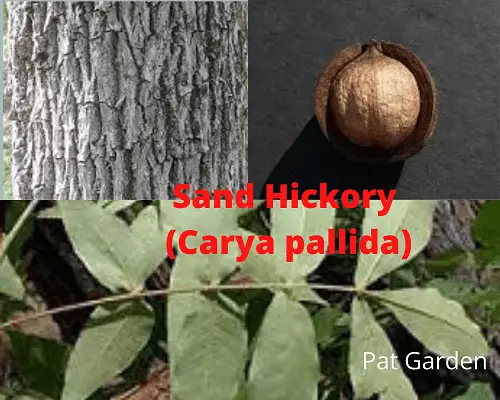
These hickories have a smooth trunk with shallow ridges in a network-type pattern. They are also slow-growing deciduous trees with shiny pinnate leaves.
Sand hickories can reach 80 feet tall and produce edible drupes. The pinnate compound leaves have several leaflets with pointed leaflets.
| Hickory Tree Bark | Smooth with shallow ridges |
| Hickory Tree Leaves | Shiny green pinnate leaves |
| Hickory Tree Nuts | Edible drupes |
| Maximum Height | 80ft |
Red Hickory (Carya ovalis)
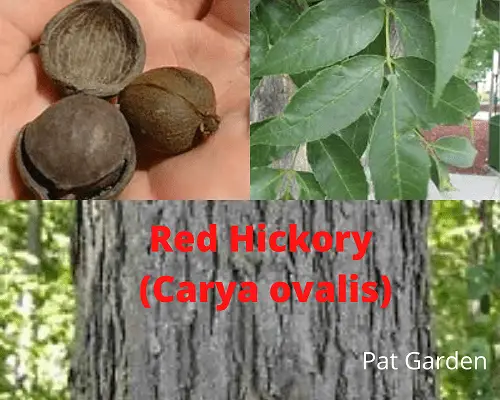
The hickory species has a single straight trunk with gray bark and flaking plates. These hickories grow on slopes and ridges with dry sandy soil.
Red hickory trees range from medium-sized to large shade trees and can grow up to 100ft. The tree produces small oval nuts whose taste varies from bitter to sweet.
| Hickory Tree Bark | Gray with flat ridges |
| Hickory Tree Leaves | Seven smooth leaflets with serrated margins. |
| Hickory Tree Nuts | Small oval nuts |
| Maximum Height | 100 ft |
Pecan (Carya illinoinensis)
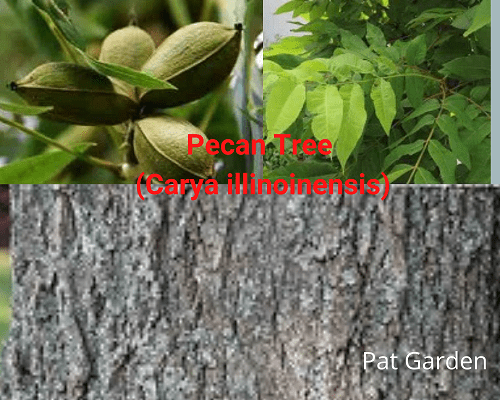
These hickories have grayish-brown bark and thick narrow fissures. They are usually large to provide plenty of shade underneath.
Pecan hickories are famous for their tasty nuts with rich brown and thin husk. The nuts have an oblong shape and buttery flavors with a waxy texture.
| Hickory Tree Bark | Reddish-brown or gray bark with flat scales and deep fissures. |
| Hickory Tree Leaves | 15 leaflets on each pinnate leaf |
| Hickory Tree Nuts | Rich brown tasty drupes |
| Maximum Height | 75 ft |
How Fast Does a Hickory Tree Grow?
Hickory trees are slow-growing deciduous trees with less than 12-inches per year. But the tree can live up to 100 years with minimal care and maintenance routine.
Hickories take 10 to 15 years to begin producing nuts. We recommend applying fertilizer every early spring a year to facilitate a faster growth rate.
How Big Does a Hickory Tree Get?
Hickory trees can reach 60 to 80 feet tall (18-24m) and spread to about 40feet (12m). Hickories provide ornamental shade due to their high branching characteristics.
Hickory trees can tolerate all soil types but prefer fertile and well-draining soil. Be sure to plant your hickories away from power lines or buildings to avoid interference.
Where Can You Plant Your Hickory Tree?
Hickories are native to North America in the eastern and Midwestern regions. These trees thrive in a humid and moist environment in temperate climates.
We recommend planting your hickories in an open landscape or in between forests of maples, oaks, and pines. They also love sloppy terrain or neutralized urban settings like streets and parks.
Conclusion
Hickories are aesthetic and multifunctional trees. They not only provide ornamental shade but also durable and high-quality wood that comes with numerous applications in the timber industry and nuts for cuisines.
Different types of hickory trees have similar characteristics. But we can differentiate them based on their leaves, nuts, and bark. My favorite hickory tree varieties are shagbark hickory, shellbark hickory, and pignut hickory.
We hope this guide to hickory tree descriptions will help you make an informed decision before planting any hickory species. Feel free to share the information with your friends or family and leave feedback in the comment section.
Readers Who Read This Also Read:
